2025 (January-December) Travel Trend Outlook
JTB has compiled a report on the 2025 travel trend outlook. The survey provides estimates on overnight or longer trips of Japanese residents traveling in Japan (including business trips and visits to hometowns) and of international visitors traveling to Japan. The estimates are made based on data such as economic indicators, consumer behavior surveys, transport/tourism related data, and surveys conducted by the JTB Group. The survey has been conducted continuously since 1981. The estimated size of the travel market in 2025 is as follows.
●The number of Japanese travelers for the year 2025 is estimated at 319.1 million (102.9% of 2024).
●The number of domestic travelers in 2025 is projected at 305 million (102.7% of 2024). The travel spending per capita is estimated at ¥47,800 (101.1% of 2024). Total domestic travel spending is forecast at ¥14,590 billion (103.8% of 2024).
●The number of outbound travelers in 2025 is estimated at 14.1 million (108.5% of 2024). The travel spending per capita is projected at ¥334,100 (106.2% of 2024). Total outbound travel spending is estimated at ¥4,710 billion (115.2% of 2024).
●The estimated number of inbound travelers to Japan in 2025 is 40.2 million (108.9% of 2024).
[Domestic travel trend of Japanese residents]
➢ The environment around employment and wages is expected to gradually improve and gradual improvement is also forecast for living conditions as well. These positive factors are expected to boost the travel appetite.
➢ Since prices are expected to continue rising, travel spending per capita is projected to continue increasing due to high prices.
[Outbound travel trend of Japanese residents]
➢ In recent years, due to the acceleration in the yen's depreciation, a trend of holding off on outbound travel is apparent, but the calming of currency exchange rate fluctuations is expected to lead to an increase in outbound travel by Japanese residents.
➢ In addition to nearby destinations such as East Asia, the number of travelers to Europe, Oceania, and other medium- and long-distance destinations is also expected to rise. A further increase from the previous year for travel spending per capita is projected.
[Inbound travelers to Japan]
➢ The number of inbound travelers to Japan in 2025 is forecast to exceed the record-high number of inbound travelers in 2024.
➢ However, the sharp demand in recovery following the COVID-19 pandemic is expected to settle down, and consequently, a more gradual growth rate compared to the previous year is projected.
(Figure 1) 2025 Annual Travel Trend Estimates
 *Domestic travel spending means total expenditures incurred after leaving home and until returning home. It includes spending at travel destinations such as shopping and meals and does not include spending before and after a trip (e.g., the cost of purchasing clothing or other travel goods).
*Domestic travel spending means total expenditures incurred after leaving home and until returning home. It includes spending at travel destinations such as shopping and meals and does not include spending before and after a trip (e.g., the cost of purchasing clothing or other travel goods).
*Outbound travel spending includes travel expenditures (including fuel surcharges) and spending at travel destinations such as shopping and meals. It does not include spending before and after a trip (e.g., the cost of purchasing clothing or other travel goods). *The numbers of domestic travelers and outbound travelers both include those on business trips and those visiting their hometown. *For inbound trips, only the number of inbound travelers to Japan is estimated. Travel spending is not calculated.
*Figures at or below the second decimal point are rounded off for comparisons with previous years and with 2019.
*Because the survey results are rounded off, there could be discrepancies in the sub-totals or differences with previous years' figures.
1. Status of travelers
With respect to domestic travel, in 2024, the number of visitor nights stagnated due to the discontinuation of government support for inbound tourism by Japanese residents implemented the previous year and price hikes in Japan. The total visitor nights from January to November 2024 stood at 448,580,000, representing 97.6% of the same figure for the same period in 2023 (459,750,000) and 101.4% of the same figure for the same period in 2019 (442,320,000) (Figure 2).
For international travel, the recovery in the number of outbound travelers was delayed in 2024 partly due to price hikes in Japan and around the world, weak yen, and global political instability. Japanese resident outbound departures during the January-November 2024
period stood at 11,820,000, representing 136.2% of the same figure for the same period in 2023 (8,676,000 departures) and 64.3% of the same figure for the same period in 2019 (18,368,000 departures) (Figure 2).
Recovery in inbound tourism accelerated in 2024 due to factors such as the weak yen and low prices in Japan. The number of inbound travelers to Japan during the January-November 2024 was 33,380,000 representing 149.5% of the same figure for the same period in 2023 (22,332,000) and 113.7% of the same figure for the same period in 2019 (29,356,000) (Figure 2). By country and region, the largest number of inbound travelers to Japan during the January-November 2024 period came from South Korea (7,950,000; 128.7% of the same period in 2023, 149.0% of the same period in 2019), followed by China (6,377,000; 301.8% of the same period in 2023, 71.8% of the same period in 2019), and Taiwan (5,553,000; 146.0% of the same period in 2023, 122.3% of the same period in 2019) (Figure 3).
According to the survey, more than 60% of the respondents went on overnight or longer inbound trips during the January-December 2024 period. For the number of inbound trips, 22.9% of the respondents answered one trip, 16.5% selected two trips, 8.9% answered three trips, and 12.3% chose four trips or more. By gender and age, women aged 29 or below ranked top at 80.7% followed by women in their 30s (72.1%), men aged 29 or below (69.4%), and men in their 30s (67.2%). The results illustrate the popularity of inbound trips among the younger generations and particularly among women (Figure 4). By place of residence of the respondents, "Chugoku/Shikoku" residents are the largest at 63.9%, followed by "Kinki (62.2%)," and "Tohoku (61.8%)" residents (Figure 6).
For international travel, 8.7% of the respondents answered they went on international trips. By gender and age, men aged 29 or below were ranked top at 17.1%, followed by women aged 29 or below (14.6%), men in their 30s (11.2%), and men in their 40s (8.0%) (Figure 5). Similar to the results for inbound trips, international travel was popular among younger generations while slightly more male respondents went on international trips than female respondents. By place of residence of the respondents, "Kanto" residents are the largest at 11.9%, followed by "Kyushu (including Okinawa) (9.1%)," and "Kinki (8.6%)" (Figure 6).
(Figure 2) Inbound Travelers to Japan in the January-November 2024 Period (Cumulative) (Comparison with 2023 and 2019)

Source: Visitor nights statistic surveys by the Japan Tourism Agency (the first preliminary figure for November 2024, the second preliminary figure for January-October 2024, and definitive figures for 2023 and 2019)/numbers of inbound travelers to Japan and Japanese resident outbound departures provided by the Japan National Tourism Organization (JNTO); (Japanese resident outbound departures: An estimate for November 2024, a provisional figure for January-October 2024, and definitive figures for 2023 and 2019; numbers of inbound travelers to Japan: An estimate for October and November 2024, a provisional figure for January-October 2024, and definitive figure for 2023 and 2019)
(Figure 3) 2024 Inbound Travelers to Japan by Country in the January-November 2024 Period (Cumulative) and Comparison with 2023 and 2019 (Top 7 Countries)

(Figure 4) 2024 Domestic Travel Experience (By gender and age, single answer)
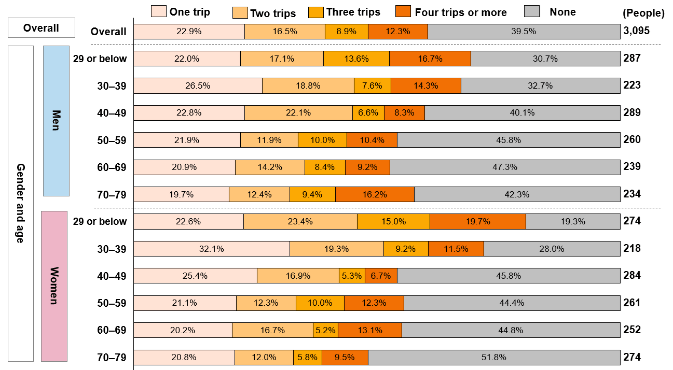
(Figure 5) 2024 International Travel Experience (By gender and age, single answer)
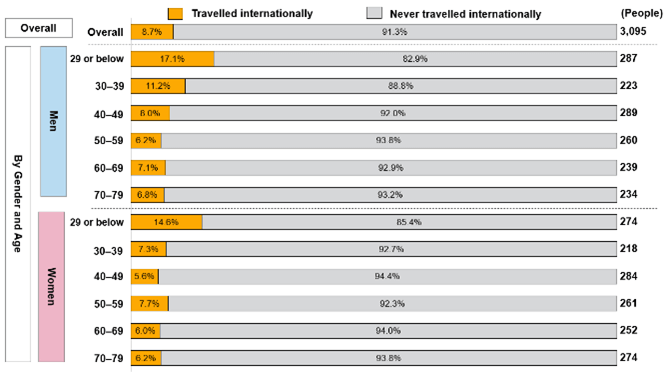
(Figure 6) 2024 Travel Experience (By area of residence, single answer)

2. 2025 calendar and major events
There are nine long weekends in 2025. This number is two fewer than 2024, which had 11 long weekends. While the Golden Week holidays are split into the first long weekend (Saturday, April 26 to Tuesday, April 29) and the second long weekend consisting of four consecutive holidays (Saturday, May 3 to Tuesday, May 6). The first long weekend could also consist of four consecutive holidays from Saturday, April 26 to Tuesday, April 29, if one takes time off work from Monday, April 28. In summer, if one takes time off work during the Obon festival period (Tuesday, August 12 to Friday, August 15), there will be nine consecutive holidays from Saturday, August 9 to Sunday, August 17. The 2025/26 yearend/new year period can be turned into nine consecutive holidays from Saturday, December 27 to Sunday, January 4, if one takes time off work on Monday, December 29 and Wednesday, December 31.
Major facilities scheduled to be open and events to be held in 2025 are as shown in Figure 7 below.
 *The red boxes indicate national holidays.
*The red boxes indicate national holidays.
[1] Event: Expo 2025, Osaka, Kansai, Japan
The Expo will be held under the theme of "Designing Future Society for Our Lives" with the aim of contributing to the achievement of the United Nation's sustainable development goals (SDGs) and realization of Japan's Society 5.0 national strategy. More than 160 countries and regions, international institutions, and private companies will participate. The Expo is targeting the creation of innovation by cutting-edge technology and revitalization of international exchange and stimulation of the local economy.
In addition, interaction promotion and an economic ripple effect through collaboration with neighboring cities and tourism destinations near the Expo venue and Setouchi Triennale 2025 are expected.
[2] Event: Setouchi Triennale 2025
The Setouchi Triennale is an art festival integrating contemporary art, nature, and cultureof the islands of the Seto Inland Sea held every three years since 2010. The Triennaletargets the resurgence of energy from when the islands, which are now facing an aging population and depopulation, were busy as a shipping route and promotes the allure of the region to the world. This year marks the sixth event and a synergy effect with Expo 2025 is also expected.
[3] Leisure and Shopping Facilities: JUNGLIA
JUNGLIA is a theme park scheduled to open in the area stretching from Nakijin Village to the City of Nago in Okinawa Prefecture. Under the concept of "Power Vacance!!," JUNGLIA offers unique experiences available only in Okinawa that cannot be enjoyed in urban areas. Starting with dinosaur safari and a hot air balloon ride, the theme park is packed with attractions utilizing the plentiful nature. The theme park will be also home to restaurants and a spa.
(Figure 7) Main Facilities to Open and Events Scheduled in 2025
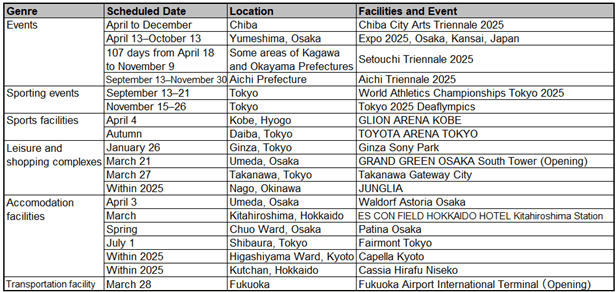 Source: Prepared by JTB Research & Consulting Co. primarily based on articles and websites, etc.
Source: Prepared by JTB Research & Consulting Co. primarily based on articles and websites, etc.
3. Domestic travel trends *Domestic trips of residents of Japan excluding international inbound travelers
The number of domestic travelers in 2025 is projected at 305 million (102.7% of 2024 and 104.7% of 2019).
The average spending per capita is estimated at ¥47,800 (101.1% of 2024 and 125.5% of 2019).
Total domestic travel spending is forecast at ¥14,590 billion (103.8% of 2024 and 131.2%of 2019)
For 2025, the number of domestic travelers is estimated at 305 million (102.7% of the same figure in 2024 and 104.7% of 2019), average spending per capita at ¥47,800 (101.1% of the same figure in 2024 and 125.5% of 2019) due to the expected continuation of high prices, and total domestic travel spending at ¥14,590 billion (103.8% of the same figure in 2024 and 131.2% of 2019).
While prices are continually expected to rise, a gradual improvement in employment and wages is projected. The living environment is anticipated to gradually improve, which could boost travel demand.
With respect to the current international travel intentions of respondents for overnight or longer trips for the year of January-December 2025 in the earlier-mentioned survey, the most popular answer was "One trip" at 28.3%, followed by "Two trips (20.5%)," "Three trips (11.2%)," and "Four trips or more (14.5%)" (Figure 8). By gender and age, women aged 29 or below was the highest at 86.5%, followed by women in their 30s (81.2%), men in their 30s (78.0%), and women in their 70s (75.9%). By place of residence of the respondents, the "Chugoku/Shikoku" residents are the largest at 77.7%, followed by "Kinki (77.6%)" and "Chubu (75.6%)" residents (Figure 9).
On the other hand, 25.4% of the respondents answered "None" for current domestic travel intentions. The most popular reason was "I don't have enough money in my household" with 35.4%, followed by "Travel costs are high (23.4%)," and "I am not interested in travel (14.6%)." The results illustrate the ongoing difficult financial situation (Figure 10).
Respondents answering that they will travel domestically were also asked a question about possible factors for their destination selections. The most popular answer was, "Places abundant with nature (national parks and flower fields, etc.)" with 31.4%. By category, "Tourism facilities" including theme parks were popular (Figure 11). On current planned travel destinations, "Chubu (Tokai, Koshinetsu, Hokuriku)" ranked first with 33.8%, followed by "Kyushu (including Okinawa) (31.7%)" and "Kanto (31.3%)." For Hokkaido and Kyushu, intra-regional travel, i.e., destinations and places of residence are the same, is popular, while a certain number of travelers from Kanto and Kinki plan visits to distant destinations such as Hokkaido, Kyushu, and Okinawa (Figure 12).
(Figure 8) 2025 Future Domestic Travel Intentions (By gender and age, single answer)
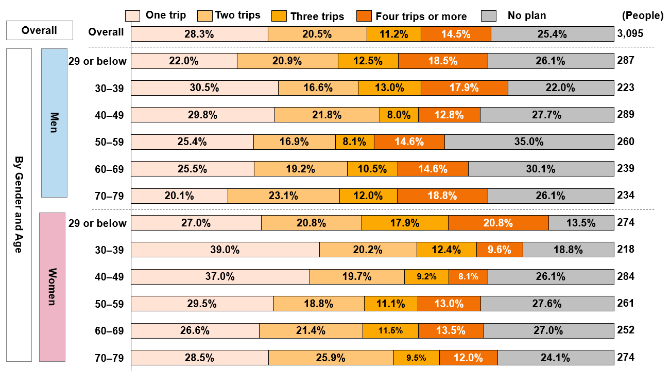
(Figure 9) 2025 Future Domestic Travel Intentions (By area of residence, single answer)
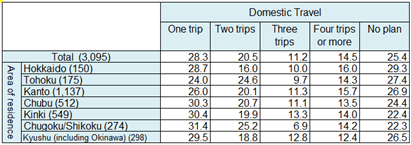
(Figure 10) Reasons for Not Traveling Domestically This year (By gender and age, multiple answers)

(Figure 11) Potential Factors for the Selection of Domestic Travel Destinations (Multiple answers)

(Figure 12) Domestic Travel Destinations (By place of residence, multiple answers)
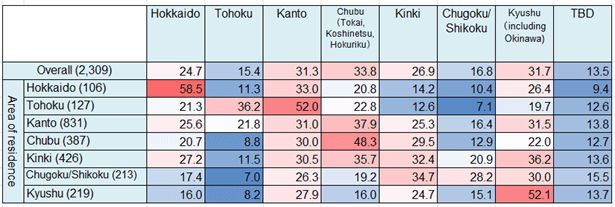
4. International travel trends
The number of outbound travelers in 2025 is estimated at 14.1 million (108.5% of 2024 and 70.3% of 2019).
The average spending per capita is projected at ¥334,100 (106.2% of 2024 and 140.9% of 2019).
Total outbound travel spending is estimated at ¥4,710 billion (115.2% of 2024 and 98.7% of 2019).
In 2025, the number of outbound travelers is estimated at 14.1 million (108.5% of the same figure in 2024 and 70.3% of 2019), average spending at ¥334,100 (106.2% of the same figure in 2024 and 140.9% of 2019) due to the continuing impact of the cheaper yen and overseas inflation, and total outbound travel spending at ¥4,710 billion (115.2% of the same figure in 2024 and 98.7% of 2019).
Recently, the tendency of withholding from international travel was apparent due to the sharp depreciation of the yen. However, when the exchange rates settle down in the future, the demand for international travel is expected to rise. The number of travelers for medium- to long-distance destinations such as Oceania and Europe are growing in addition to nearby destinations such as East Asia. Consequently, travel spending per capita is expected to exceed the previous year even more.
With respect to the respondents' current intentions for overnight or longer international travel for the year of January to December 2025, 21.1% of the respondents answered they will travel internationally. Considering the fact that 8.7% of the respondents travelled internationally in 2024, it can be said that the results show a significant increase. By gender and age, women aged 29 or below ranked top with 34.3%, followed by men aged 29 or below (27.5%), and men in their 30's (26.0%) (Figure 13).
By place of residence, the percentage of respondents answering they will travel internationally is highest in "Kanto" with 24.5%. "Kinki (22.6%)" and "Chubu (18.6%)" are next (Figure 14).
With respect to the current planned travel destinations of respondents, the most popular destination was "South Korea (30.4%)" followed by "Taiwan (26.4%)." While nearby destinations are popular, medium- to long- distant destinations such as "Hawaii (24.2%)" and "Europe (18.4%)" are also popular. By gender and age, South Korea was popular among women aged 29 or below and Taiwan was a popular destination for men in their 40s and women in their 50s, while Europe is popular for women in their 70s. The results illustrate the differences among the generations (Figure 15).
On the other hand, 78.9% of the respondents answered, "Will not travel internationally." For the reasons, the most popular reason was "Travel costs are high" with 33.6%, followed by "I don't have enough money in my household (26.4%)" and "Yen is weak (24.4%)". The top three answers were economic reasons for this question as well. Looking at the reasons by gender and age, the popular reasons for women in their 70s were expired passports, concerns over public safety, and physical concern for travel while among men in their 50s, "I can't take days off from work" ranked top. Differences due to life stage are also apparent (Figure 16).
(Figure 13) 2025 International Travel Plans (By gender and age, single answer)
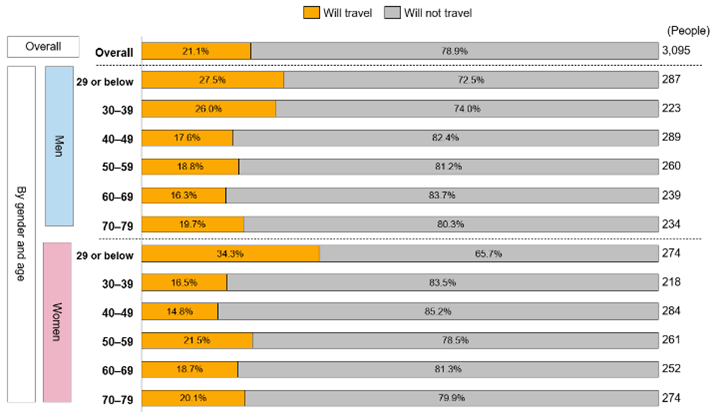
(Figure 14) 2025 International Travel Plans (By area of residence, single answer)
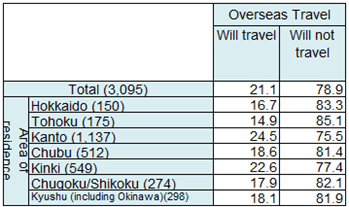
(Figure 15) International Travel Destinations (By gender and age, multiple answers)

(Figure 16) Reasons for Not Traveling Internationally This Year (By gender and age, multiple answers)
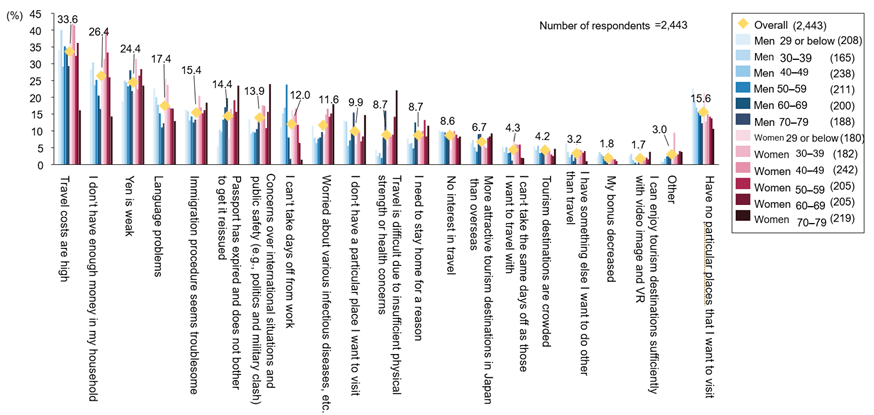
5.Number of inbound travelers to Japan
The estimated number of inbound travelers to Japan in 2025 is 40.2 million (108.9% of 2024 and 126.1% of 2019).
The number of inbound travelers to Japan in 2025 is estimated at 40.2 million (108.9% of the same figure in 2024 and 126.1% of 2019).
In 2024, international inbound travelers surged due to favorable conditions such as the significant depreciation of the yen and the end of the COVID-19 pandemic. The rate of the total number of inbound travelers to Japan for January-October 2024 was the fastest ever reaching 30 million people and is expected to exceed 35 million people a year. In 2025, an even larger increase is projected, and Japan is expected to welcome a record-breaking number of international inbound travelers. Although 40 million inbound travelers are projected, the growth rate is expected to be gradual with 108.9% of the same figure of 2024 as it is believed that the significant demand in recovery following COVID-19 will slow down.
By country and region, as discussed in "1. Status of travelers," the total numbers of visitors for January-November 2024 from South Korea, Taiwan, the United States, Hong Kong, and Australia out of the top seven countries where the number of international inbound travelers are from have already exceeded the same figure of 2019, which is a pre-COVID year. A further increase is expected in 2025 as well primarily for inbound travelers to Japan from neighboring markets. The recovery in the number of inbound travelers to Japan from China is delayed, but there is the possibility of recovery to the 2019 level once conditions for recovery including the relaxation of visa restrictions take hold.
Based on this situation, the survey respondents were asked about their thoughts about the increase in international inbound travelers. For positive responses, "I welcome international inbound travelers since it will lead to the revitalization of the Japanese economy overall" ranked top with 34.2%. In particular, the answer was popular among men aged 29 years or below, in their 30s, and in their 40s along with women in their 50s. "I welcome international inbound travelers since it will lead to the revitalization of local economies overall (23.2%)" and "I welcome international inbound travelers since tourism destinations will become busy (17.8%)" were next. On the other hand, for concerned voices, the most popular answer was "Worried about the deterioration of manners in tourism destinations (43.4%)." "Worried about the negative impact on tourism resources, facilities, and nature (31.9%)" and "Worried about the negative impact on the daily life of the residents (31.3%)" were the next most popular answers. These answers tended to be selected by respondents in their 50s and over for both men and women. The results illustrate that the younger generations consider the increase of international inbound travelers as a positive factor for revitalization of the economy and vitality of the regions of Japan (Figure 17).
Currently, Japan is implementing measures to prevent overtourism as part of sustainable tourism as a nation. Tourism measures to increase the satisfaction of not only international inbound travelers but also Japanese domestic travelers and local residents are attracting attention.
(Figure 17) Thoughts about the Increase in International Inbound Travelers (By gender and age, multiple answers)
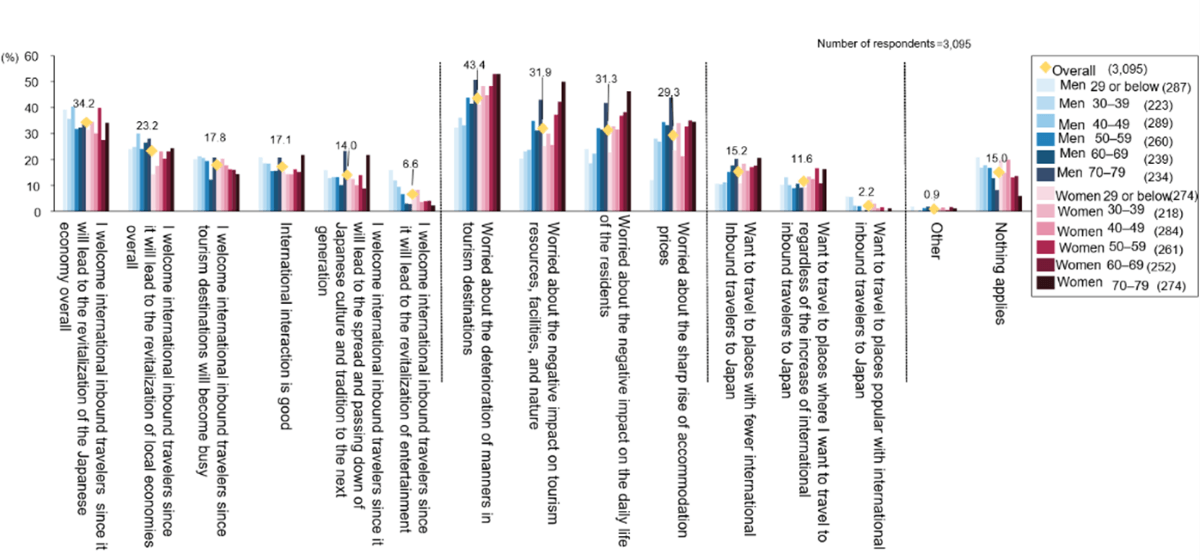
6. Economic environment surrounding traveling and living conditions
The Nikkei Stock Average (closing price) temporarily reached the ¥40,000 level in 2024, but it has seesawed in the lower ¥30,000 range overall since September 2024. Meanwhile, the country's economic outlook remains uncertain due to price hikes in Japan and overseas, continuous high-interest rate standards in European countries and the United States, and global instability. The World Economic Outlook released by the International Monetary Fund (IMF) in October 2024 forecasted Japan's growth rate in 2024 at 0.3% and in 2025 at 1.1%. A recovery is expected.
Looking at the current economic conditions, the trend of the rising US dollar against the Japanese yen continued in 2024. In early July 2024, the closing price of the US dollar against the Japanese yen reached the ¥161 mark on the FOREX market. Later, a correction of the yen's depreciation was apparent, but the US dollar against the Japanese yen remained in the ¥158 range as of December 30, 2024. This depreciation of the yen situation is having a material impact primarily on prices (Figure 18). Looking at the consumer price index of major items, while the cost of electricity has relatively been stable thanks to the subsidies continuously provided by the Japanese government until November 2024 (reflected in the data until December), everything except transport and telecommunication costs remains high. In particular, a significant increase in prices of perishable foods is notable (Figure 19). Looking at consumer sentiments, according to the current living conditions illustrated in a Bank of Japan survey on consumer sentiment, the ratio of respondents who said they have "Less cost-of-living pressure" recorded its highest response in September 2024 since December 2022. On the other hand, the ratio of respondents selected "More cost of living pressure" is the lowest. The results indicate the daily lifestyle situation is gradually improving (Figure 20). In JTB's above-mentioned survey, survey respondents answering they will travel during 2025 were asked about their spending intention on travel in the next year. The number of respondents who selected, "I want to spend more (25.7%)" exceeded "I want to spend less (10.5%)," indicating an increasing trend for travel expenses (Figure 21).
(Figure 18) 2024 FOREX Rates of Major Currencies Against the Yen
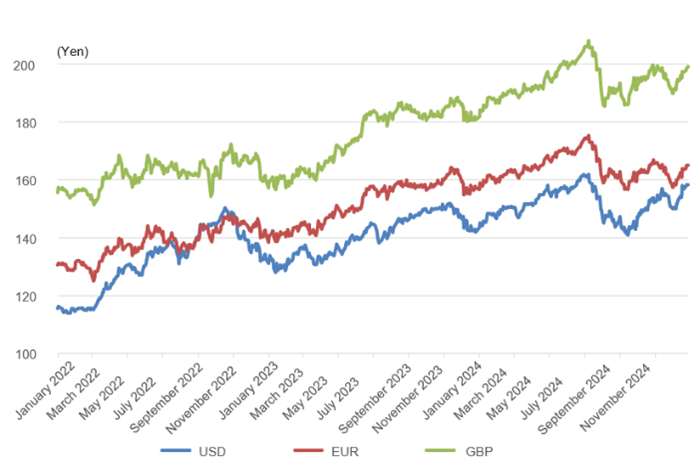
Source: Telegraphic Transfer Middle Rate (TTM) in the Tokyo FOREX market (FOREX data provided by Mitsubishi UFJ Research & Consulting Co., Ltd.)
(Figure 19) Consumer Price Index of Major Items
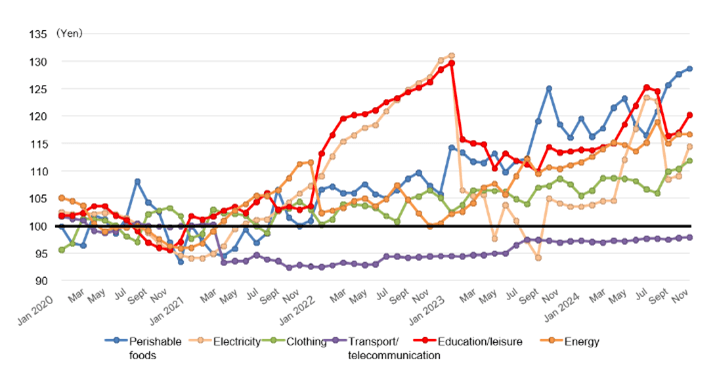
Source: Prepared by JTB Tourism Research & Consulting Co. based on consumer price index data(2020=100) provided by the Ministry of Internal Affairs and Communications, Japan
(Figure 20) Current Living Conditions
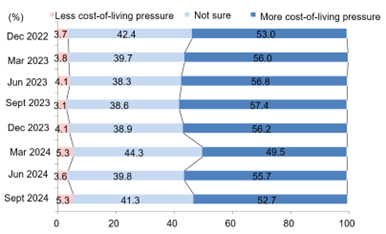
Source: Prepared by JTB Tourism Research & Consulting Co. based on data from the consumer sentiment surveys conducted by the Bank of Japan
(Figure 21) Spending Intention on Travel in the Next Year (Single answer, number of respondents=2,326)
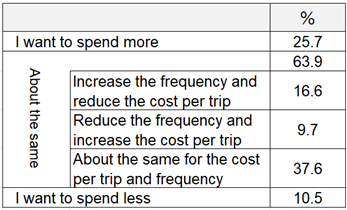
[2025 Travel Survey: Survey Methodology]
Fieldwork dates: November 29 to 30, 2024
Survey methodology: Online survey (outsourced to: Macromill, Inc.)
Respondents: Men and women aged 15 to 79 nationwide
Sample size: 3,095 for the main survey
Survey contents: Travel for January 1, 2025, to December 31, 2025
*The numerical figures in the survey results do not match some of the subtotals and the differences from the figures in the previous year are due to rounding off the numerical figures in the survey results.
(Figure 22) 2000-2023 Estimates and 2024-2025 Forecasts
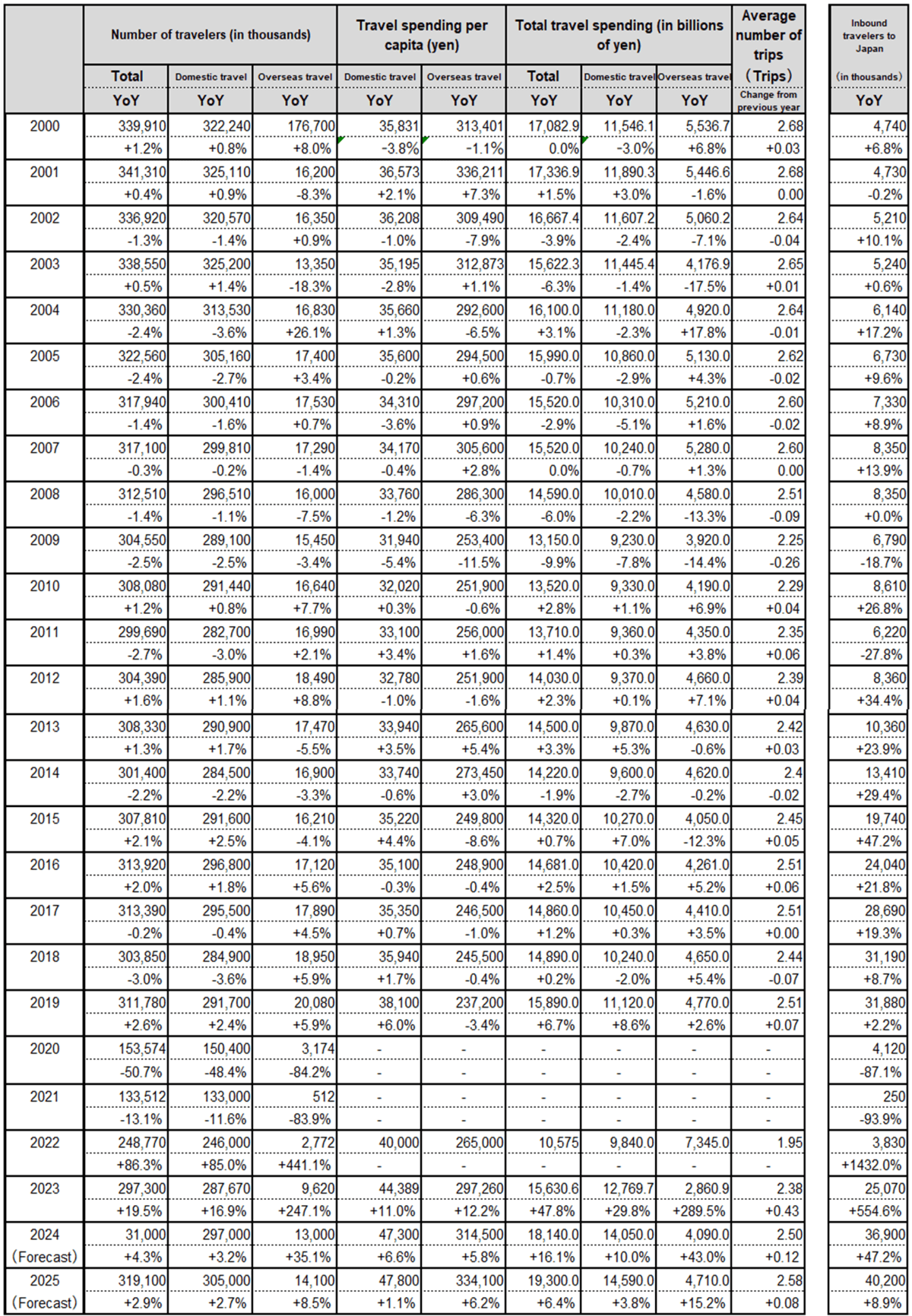
*The number of travelers for domestic travel is estimated based on actual figures for 2000 to 2023 and an estimate for 2024 and 2025.
*The number of travelers for overseas travel and the number of inbound travelers to Japan are actual figures from 2000 to 2023 and an estimate for 2024 and 2025.
JTB Corp. Public Relations team
Phone: +81 3 5796 5833
